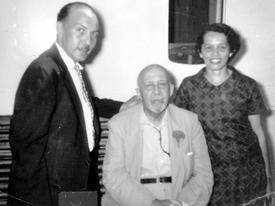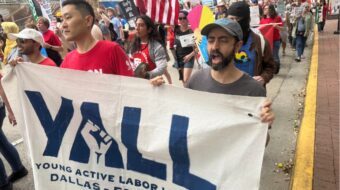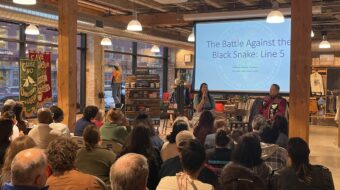
The symposium “James and Esther Jackson, the American Left and the Origins of the Modern Civil Rights Movement” at the Tamiment Library of New York University on Oct. 28 was an event of singular enlightenment and emotional impact. Three panels of academics and activists delivered papers illuminating the little-known lives of the Jacksons, their co-workers and the struggles in which they participated that helped shape developments in our country from the late 1930s to the present. The symposium announced the opening of the Jacksons’ papers.
Angela Davis keynoted the event with an appreciation of the Jacksons, whom she knew from her teen years. Her mother Sallye Davis was a co-worker of the Jacksons in the Southern Negro Youth Congress from the late 1930s through the mid-1940s.
David Levering Lewis, Pulitzer Prize-winning biographer of W.E.B. Du Bois, delivered a paper on the role of the Southern Negro Youth Congress, the Jacksons and Du Bois.
Some 250 students, historians, academics, colleagues and political leaders packed the library’s hall. Sam Webb, Communist Party USA national chair, and national board members and longtime friends of the Jacksons, Debbie Amis Bell and this writer, represented the CPUSA.
Percy Sutton, former Manhattan borough president, took the floor and spoke of his long association with and appreciation of the Jacksons. This began in Texas where Sutton grew up in a family of 12, half of whom became Communists.
Pete Seeger also talked of his great appreciation for the Jacksons’ contributions. He then taught the audience a new political song.
One of the academics who worked on the Jacksons’ papers read from the daily letters exchanged between James and Esther during World War II. James was stationed in Burma. They were poignant letters of love and political commentary on the world and domestic situation.
Michael Nash, Tamiment Library director, and others presented papers on the key role the Jacksons and other notables from the Young Communist League and CPUSA played in establishing and organizing the Youth Congress. The Jacksons’ co-workers included Louis and Dorothy Burnham, Edward and Augusta Strong, Grace Bassett and Chris Alston. The Youth Congress grew to 100,000 members throughout the South. They did voter registration and organized tobacco and other workers into unions. These pioneers were active in fighting every violation of civil rights, at great risk to their personal safety.
The Youth Congress and other movements, like the International Labor Defense headed by Joseph Brodsky and William L. Patterson, were forerunners of the movement around the 1954 Supreme Court school desegregation decision, the Montgomery Bus Boycott of 1956, and the civil rights revolution that began in 1960.
Jean Carey Bond, former associate editor of Freedomways, told of Esther Jackson’s role as its managing editor for 25 years, and of Du Bois in its founding, as well as how the magazine, during and after the civil rights revolution, was a political and cultural voice of the movement.
Former New York Times book review editor Michael Anderson delivered a paper about Lorraine Hansberry and her days as an editor, working under Louis Burnham, on Freedom, the newspaper Paul Robeson published. Later Hansberry was associate editor of New Challenge, the magazine of the Young Communist League. She became the great playwright of the freedom movement.
Maurice Jackson, Georgetown University history professor and longtime friend of the Jacksons, and Timothy Johnson, NYU librarian and former co-worker of James Jackson, both chaired panel discussions.
Charlene Mitchell, longtime co-worker and friend of the Jacksons and co-chair of the Committees of Correspondence for Democracy and Socialism, presented the final paper. This paper defended the role of the Communist Party in relation to the Black Panther Party. While disagreeing with the Panthers on important ideological and political points, the Communist Party always defended them against the government’s attacks, a point now disputed by some on the left.
Aspects of the Jacksons’ lives mentioned only briefly or not at all included James Jackson’s role as CPUSA Southern Affairs secretary. At that time Jackson worked in close association with Rosa Parks, a relationship which had begun in the days of the Youth Congress and continued during the Montgomery Bus Boycott. As The Worker’s editor, Jackson worked with a number of the leaders of the civil rights revolution.
Another interesting aspect was when Esther Jackson headed the Civil Rights Congress in Detroit and James Jackson was educational director of the party’s Ford autoworkers section, which had hundreds of members. The Jacksons forged a lifelong friendship with autoworker and several-term mayor of Detroit Coleman Young.
James Jackson produced much theoretical work on the strategy for African American equality and on many other subjects while heading the education work of the Communist Party. He produced two books of political writings and served as CPUSA International Department head. He played an important role in world and U.S. peace and solidarity movements. He interviewed Ho Chi Minh shortly before the Vietnamese leader’s death. Jackson, along with then-CPUSA National Chair Henry Winston, played an important part in helping the South African Communist Party in its struggle for freedom.
The symposium was a special event honoring the lives of two individuals who demonstrated great conviction, dedication, heroism and excellence in the struggle for equality, peace, democracy, progress and socialism. Their lives could not help but inspire many others.










